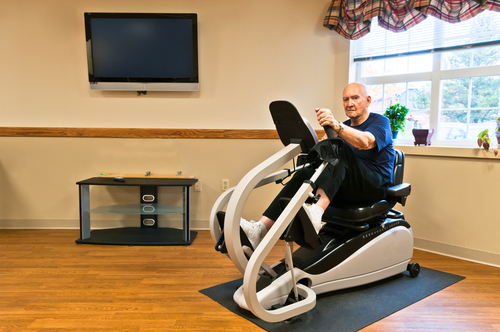Recumbent Stepper Safe, Feasible Exercise for ALS Patients, Study Suggests

Using a recumbent stepper is a safe and well-tolerated way for patients with amyotrophic lateral sclerosis (ALS) to do physical exercise, a pilot study suggests.
The study, “Recumbent stepping aerobic exercise in amyotrophic lateral sclerosis: a pilot study,” was published in the journal Neurological Sciences.
One of the most characteristic symptoms of ALS is progressive muscle weakness, typically manifesting with an asymmetric onset in either the upper or lower extremities or facial muscles. As muscle weakness worsens, it can severely affect mobility and lead to serious secondary complications.
Physical exercise may represent an effective and useful strategy to protect muscle fibers and preserve their function. However, there is the risk of exercise programs causing “overuse weakness,” provoking further damage to the muscles.
More recent evidence from mouse models of ALS contradicts this idea that exercise is a risk factor for ALS. In fact, studies have demonstrated that “moderate intensity aerobic exercise can induce neuroprotection and prolong motoneuron survival,” according to the researchers. Still, there is little evidence of the benefits of aerobic exercise in ALS patients.
Common methods of exercise such as the treadmill and cycle ergometer may not be suitable for many ALS patients, especially for those with more advanced disease who have greater motor impairments and poor trunk control.
Researchers at the University of Illinois at Chicago explored the benefits of exercise with a recumbent stepper. This type of exercise machine combines upper and lower extremity exercise with safe and supported seating.
Nine patients with ALS were enrolled in the study and performed exercise sessions for four weeks with the NuStep T5 recumbent stepper. Participants were instructed to maintain 65-70 steps per minute for 40 minutes, three times a week, at moderate intensity (50-70% maximal heart rate).
All participants were still able to walk independently or with supportive aid for at least 10 meters. They also did not have any secondary medical problems, such as cardiac or metabolic conditions or cognitive impairments.
Eight of the nine patients completed all 12 exercise sessions without adverse events. No major changes in heart rate or blood pressure were observed during the training sessions, and the participants tolerated the established exercise protocol well. During the four weeks, the protocol was described as light exercise, determined by the rating of perceived exertion scores.
“Our study is the first to demonstrate that a 4-week exercise program on a recumbent stepper is safe and well tolerated by individuals with ALS,” the researchers said. “Since ALS is a disease that requires multidisciplinary management, regular physical activity in the form of recumbent stepping has the potential for inclusion in a rehabilitation program.”
Weekly assessments of patients’ exercise capacity showed an improvement of 0.11 miles from the first week to the fourth week in total distance, but this was not statistically significant.
No significant differences were noted between the pre-, post-, and one-month assessments for any of the clinical variables, including ALS Functional Rating Scale–Revised (ALSFRS-R) scores, fatigue, mental and physical health quality, depression score, and physical resistance.
Of the nine participants, only two were eligible to evaluate changes in lower leg muscle responsiveness in the weekly assessments. However, the exercise-induced changes in motor nerve stimulation in these two ALS patients were minimal or absent.
Given the limited data on the impact of recumbent stepper-based exercise on motor nerve cell excitability, the team was unable to fully determine the potential benefits of the training protocol. Still, the participants reported that this type of training was rewarding and could help them improve their quality of life and physical fitness.
Additional studies are needed to investigate the clinical and neurophysiological effects of a longer aerobic exercise recumbent-stepping approach on a larger group of ALS patients.






